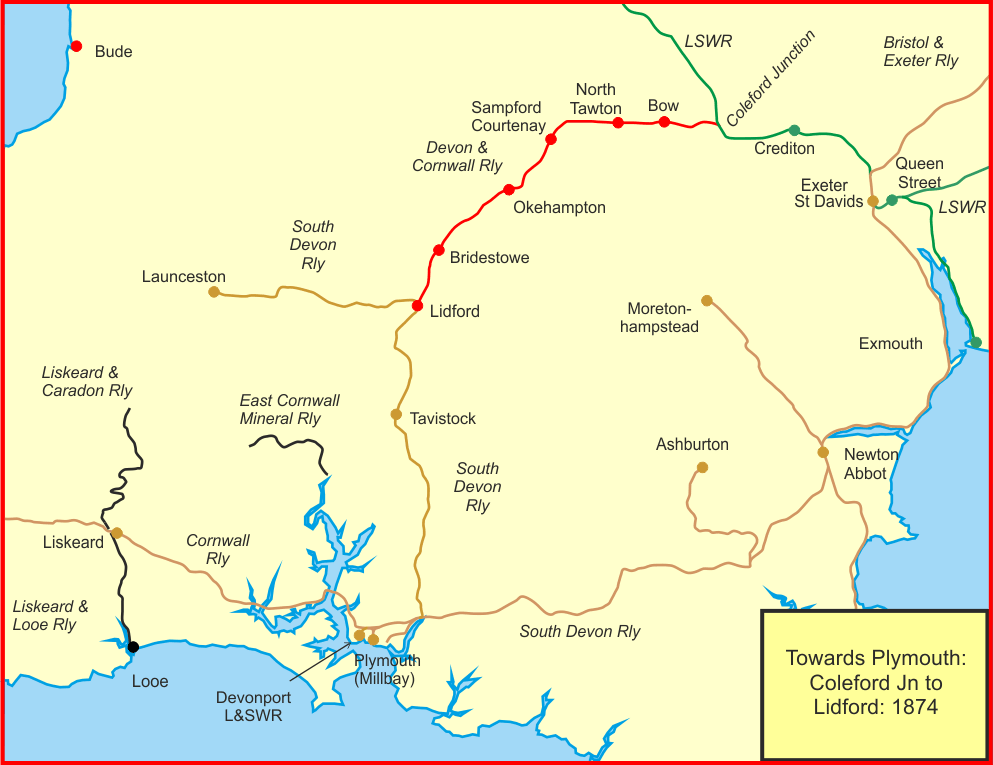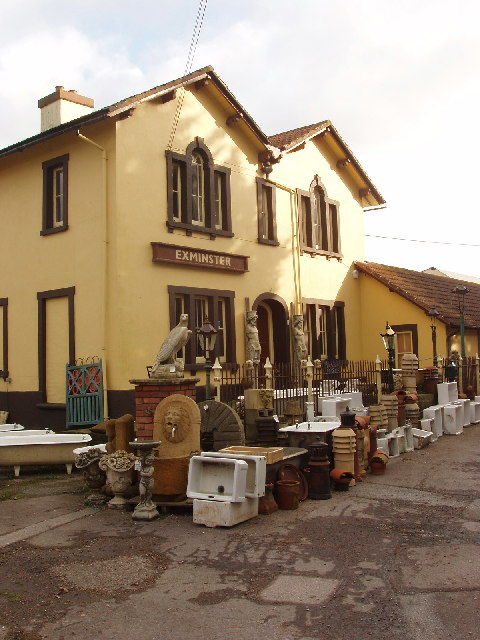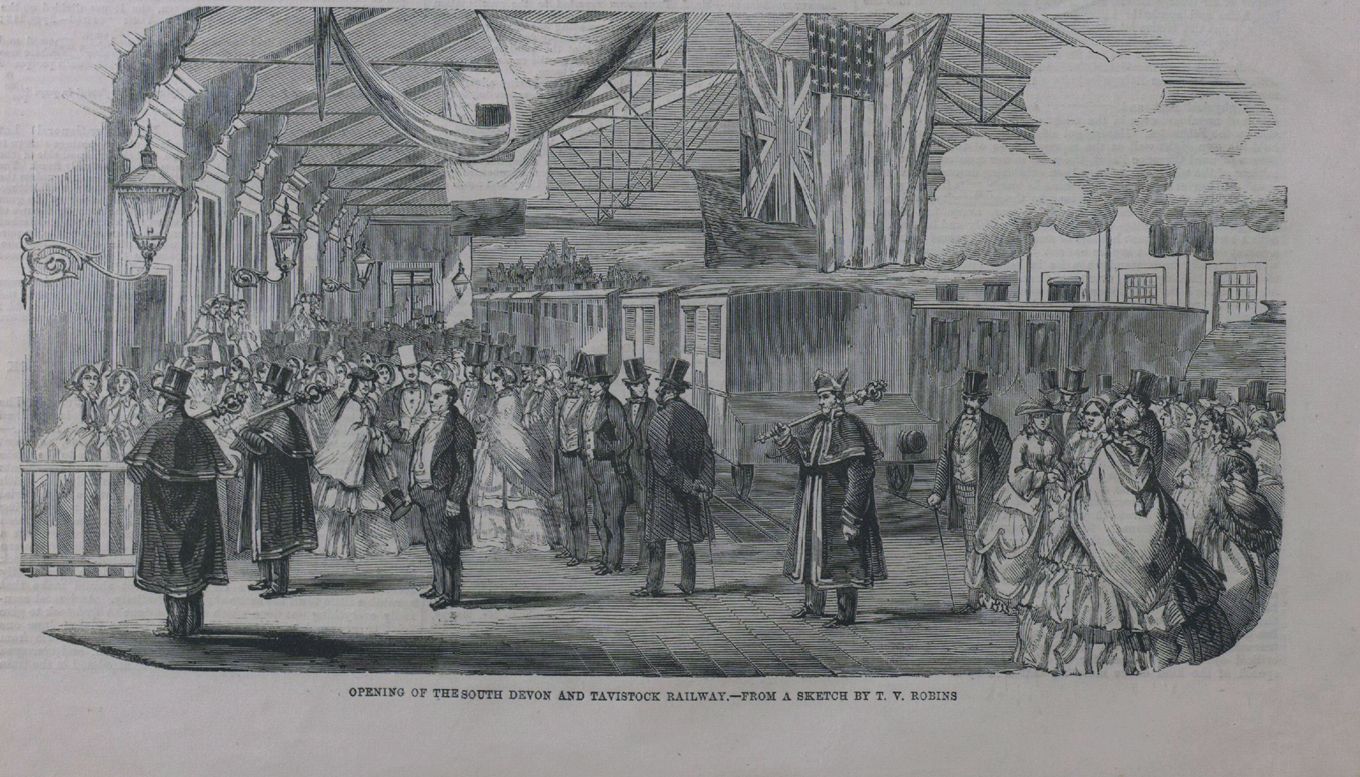|
Exeter To Plymouth Railway Of The LSWR
The Exeter to Plymouth railway of the London and South Western Railway (LSWR) was the westernmost part of a route competing with that of the Great Western Railway (GWR) and its 'associated companies' from London and Exeter to Plymouth in Devon, England. Whereas the GWR route from Exeter followed the coast to Newton Abbot and then went around the southern edge of Dartmoor, the LSWR route followed the northern and western margins of Dartmoor, passing through the towns of Crediton, Okehampton, and Tavistock. The route was constructed piecemeal by independent companies, in most cases supported by the LSWR. LSWR trains first reached Plymouth in 1876 and the route took on its final form in 1891. The central part of the line closed in 1968, leaving just local services at either end. History Railways to Exeter The broad gauge Bristol and Exeter Railway (B&ER) was the first line to reach Exeter. It had reached St Davids station in Exeter in 1844 and was allied with the Great We ... [...More Info...] [...Related Items...] OR: [Wikipedia] [Google] [Baidu] |
Meldon Viaduct
Meldon Viaduct carried the London & South Western Railway (LSWR) across the West Okement River at Meldon (near Okehampton) on Dartmoor in Devon, South West England. The truss bridge, which was constructed from wrought iron and cast iron not stone or brick arches, was built under the direction of the LSWR's chief engineer, WR Galbraith. After taking three years to build, the dual-tracked bridge opened to rail traffic in 1874. Usage was limited to certain classes of locomotive because the viaduct had an axle load limit. Although regular services were withdrawn in 1968, the bridge was used for shunting by a local quarry. In the 1990s the remaining single line was removed after the viaduct was deemed to be too weak to carry rail traffic. The crossing is now used by The Granite Way, a long-distance cycle track across Dartmoor. The viaduct, which is a scheduled monument, is now one of only two such surviving railway bridges in the United Kingdom that uses wrought iron lattice piers ... [...More Info...] [...Related Items...] OR: [Wikipedia] [Google] [Baidu] |
South Devon Railway Company
The South Devon Railway Company built and operated the railway from Exeter to Plymouth and Torquay in Devon, England. It was a broad gauge railway built by Isambard Kingdom Brunel. The line had to traverse difficult hilly terrain, and the company adopted the atmospheric system in which trains were drawn by a piston in a tube laid between the rails, a vacuum being created by stationary engines. The revolutionary system proved to have insuperable technical difficulties and was abandoned. The line continued as a conventional locomotive railway. The company promoted a number of branches, through the medium of nominally independent companies. Its original main line between Exeter and Plymouth remains in use today as an important part of the main line between London and Plymouth. Chronology * 1844 South Devon Railway Act passed by Parliament * 1846 opened to Newton Abbot * 1847 opened to Totnes, atmospheric trains start running * 1848 atmospheric trains withdrawn, Torquay branch o ... [...More Info...] [...Related Items...] OR: [Wikipedia] [Google] [Baidu] |
Mutley Railway Station
There are eleven disused railway stations between Exeter St Davids and Plymouth Millbay, Devon, England. At eight of these there are visible remains. Of the eleven stations, South Brent and Plympton are subject of campaigns for reopening while Ivybridge station was replaced by another station on a different site. Background The South Devon Railway was opened in stages between 30 May 1846 and 2 April 1849. It was originally designed to operate on the atmospheric principle but this was not successful and was never completed beyond Newton Abbot. It was amalgamated into the Great Western Railway on 1 February 1876 and now forms part of the Exeter to Plymouth Line. Stations Exminster ''Located at '' A station was built at Exminster by George Hennet. It was opened in August 1852 and operated by him on behalf of the South Devon Railway until January 1857 when the railway company took over. An Italianate building on the west side of the single track housed a booking office and ... [...More Info...] [...Related Items...] OR: [Wikipedia] [Google] [Baidu] |
South Devon And Tavistock Railway
The South Devon and Tavistock Railway linked Plymouth with Tavistock in Devon; it opened in 1859. It was extended by the Launceston and South Devon Railway to Launceston, in Cornwall in 1865. It was a broad gauge line but from 1876 also carried the standard gauge (then referred to as ''narrow gauge'') trains of the London and South Western Railway between Lydford and Plymouth: a third rail was provided, making a ''mixed gauge''. In 1892 the whole line was converted to standard gauge only. The line closed to passengers in 1962 although sections at either end were retained for a while to carry freight traffic. A short section has since been reopened as a preserved line by the Plym Valley Railway. History Getting the Tavistock line authorised The Plymouth and Dartmoor Railway, a horse-worked line, had been constructed to bring minerals from quarries near Princetown to Plymouth; it opened on 26 September 1823. The South Devon Railway (SDR) built its line from Exeter to Plymouth, o ... [...More Info...] [...Related Items...] OR: [Wikipedia] [Google] [Baidu] |
Plymouth Rail Map 1876
Plymouth () is a port city and unitary authority in South West England. It is located on the south coast of Devon, approximately south-west of Exeter and south-west of London. It is bordered by Cornwall to the west and south-west. Plymouth's early history extends to the Bronze Age when a first settlement emerged at Mount Batten. This settlement continued as a trading post for the Roman Empire, until it was surpassed by the more prosperous village of Sutton founded in the ninth century, now called Plymouth. In 1588, an English fleet based in Plymouth intercepted and defeated the Spanish Armada. In 1620, the Pilgrim Fathers departed Plymouth for the New World and established Plymouth Colony, the second English settlement in what is now the United States of America. During the English Civil War, the town was held by the Parliamentarians and was besieged between 1642 and 1646. Throughout the Industrial Revolution, Plymouth grew as a commercial shipping port, handling imports an ... [...More Info...] [...Related Items...] OR: [Wikipedia] [Google] [Baidu] |
Lydford Railway Station
Lydford railway station was a junction at Lydford between the Great Western Railway (GWR) and London and South Western Railway (LSWR) situated in a remote part of north-west Dartmoor in Devon, England. History The station, known then as "Lidford", was opened on 1 June 1865 with the Launceston and South Devon Railway, a broad gauge line that connected with the South Devon and Tavistock Railway to offer a service to Plymouth Millbay railway station. This line eventually became a part of the GWR. On 12 October 1874 the West of England Main Line, LSWR line was opened from Okehampton railway station. This was a standard gauge line that carried trains direct from London Waterloo station, whereas passengers to the GWR's London Paddington station had to travel on the branch line to Plymouth and then change onto a main line train. On 17 May 1876 a junction was opened between the two lines and LSWR trains could then reach its new station at Devonport Kings Road railway station, Dev ... [...More Info...] [...Related Items...] OR: [Wikipedia] [Google] [Baidu] |
Coleford Junction
Yeoford railway station is a rural station serving the village of Yeoford in Devon, England. It is on the Tarka Line to , from at milepost 183 from . History The station was opened by the North Devon Railway in July 1857. On 1 November 1865 the first section of the Okehampton Railway opened from Yeoford (now known as Yeoford Junction) to , although the new railway ran alongside the existing North Devon line almost to Coleford. This route was to become the London and South Western Railway main line to . To carry this extra traffic the line was doubled from Crediton to Yeoford on 1 June 1876 and onwards to a new Coleford Junction on 16 May 1877. The platform for trains going towards Plymouth and Barnstaple was given an extra track so trains could stand on both sides. There were sidings on both sides of the station but in 1943 additional long sidings were laid at the Crediton end south of the Plymouth platform so that traffic could be exchanged between the two routes. The g ... [...More Info...] [...Related Items...] OR: [Wikipedia] [Google] [Baidu] |
Consolidation (business)
In business, consolidation or amalgamation is the merger and acquisition of many smaller companies into a few much larger ones. In the context of financial accounting, ''consolidation'' refers to the aggregation of financial statements of a group company as consolidated financial statements. The taxation term of consolidation refers to the treatment of a group of companies and other entities as one entity for tax purposes. Under the Halsbury's Laws of England, 'amalgamation' is defined as "a blending together of two or more undertakings into one undertaking, the shareholders of each blending company, becoming, substantially, the shareholders of the blended undertakings. There may be amalgamations, either by transfer of two or more undertakings to a new company or the transfer of one or more companies to an existing company". Overview Consolidation is the practice, in business, of legally combining two or more organizations into a single new one. Upon consolidation, the original ... [...More Info...] [...Related Items...] OR: [Wikipedia] [Google] [Baidu] |
Thomas Brassey
Thomas Brassey (7 November 18058 December 1870) was an English civil engineering contractor and manufacturer of building materials who was responsible for building much of the world's railways in the 19th century. By 1847, he had built about one-third of the railways in Britain, and by time of his death in 1870 he had built one in every twenty miles of railway in the world. This included three-quarters of the lines in France, major lines in many other European countries and in Canada, Australia, South America and India. He also built the structures associated with those railways, including docks, bridges, viaducts, stations, tunnels and drainage works. As well as railway engineering, Brassey was active in the development of steamships, mines, locomotive factories, marine telegraphy, and water supply and sewage systems. He built part of the London sewerage system, still in operation today, and was a major shareholder in Brunel's '' The Great Eastern'', the only ship large eno ... [...More Info...] [...Related Items...] OR: [Wikipedia] [Google] [Baidu] |
Mixed Gauge
In railway engineering, "gauge" is the transverse distance between the inner surfaces of the heads of two rails, which for the vast majority of railway lines is the number of rails in place. However, it is sometimes necessary for track to carry railway vehicles with wheels matched to two different gauges. Such track is described as dual gauge – achieved either by addition of a third rail, if it will fit, or by two additional rails. Dual-gauge tracks are more expensive to configure with signals and sidings, and to maintain, than two separate single-gauge tracks. It is therefore usual to build dual-gauge or other multi-gauge tracks only when necessitated by lack of space or when tracks of two different gauges meet in marshalling yards or passenger stations. Dual-gauge tracks are by far the most common configuration, but triple-gauge tracks have been built in some situations. Background The rail gauge is the most fundamental specification of a railway. Rail tracks and whee ... [...More Info...] [...Related Items...] OR: [Wikipedia] [Google] [Baidu] |
Act Of Parliament
Acts of Parliament, sometimes referred to as primary legislation, are texts of law passed by the Legislature, legislative body of a jurisdiction (often a parliament or council). In most countries with a parliamentary system of government, acts of parliament begin as a Bill (law), bill, which the legislature votes on. Depending on the structure of government, this text may then be subject to assent or approval from the Executive (government), executive branch. Bills A draft act of parliament is known as a Bill (proposed law), bill. In other words, a bill is a proposed law that needs to be discussed in the parliament before it can become a law. In territories with a Westminster system, most bills that have any possibility of becoming law are introduced into parliament by the government. This will usually happen following the publication of a "white paper", setting out the issues and the way in which the proposed new law is intended to deal with them. A bill may also be introduced in ... [...More Info...] [...Related Items...] OR: [Wikipedia] [Google] [Baidu] |
Cowley Bridge Junction
Cowley is a hamlet in the parish of Upton Pyne in Devon, England. Cowley church was built as a chapel of ease to Brampford Speke by Rohde Hawkins in 1867–8. It is chiefly notable for a fine three-arched bridge of classical design, built over the River Creedy in 1813-14 by James Green, pupil of John Rennie and surveyor to the county of Devon. Although so recent in date, the bridge has been scheduled as an ancient monument. Cowley Bridge Junction is a railway junction on the former Bristol and Exeter Railway, that allows access to the former North Devon Railway towards Barnstaple, now renamed the Tarka Line. In 1848, the Exeter and Crediton Railway The Exeter and Crediton Railway was a broad gauge railway that linked Exeter and Crediton, Devon, England. It was 5¼ miles (8½ km) long. Although built in 1847, it was not opened until 12 May 1851 due to disagreement about the gau ... had built a station at Cowley Bridge, but it never opened. References Hamle ... [...More Info...] [...Related Items...] OR: [Wikipedia] [Google] [Baidu] |









_track%2C_South_Australian_Railways.jpg)
